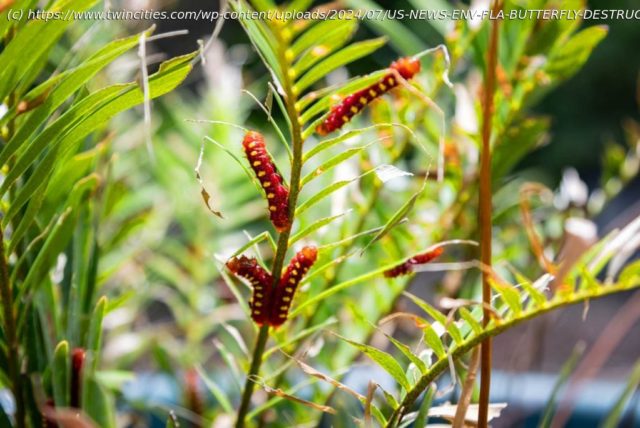The butterfly is the atala, a South Florida native whose life cycle and survival has long been tied to a unique “host plant” called the coontie.
Ashley Miznazi | (TNS) Miami Herald
A small butterfly once thought extinct has staged such a comeback in South Florida that it is now considered a bit of a garden pest — and a persistent problem for a renowned research facility where its caterpillars feast on a curated collection of tropical plants, some of them rarer than the insect munching them.
The butterfly is the atala, a South Florida native whose life cycle and survival has long been tied to a unique “host plant” called the coontie. Atala lay eggs in the thick fernlike foliage, which then provides food to emerging voracious caterpillars that will metamorphose into jet-black butterflies with bright red bodies and an iridescent teal shimmer in their wings.
The coontie, sometimes sold as the “coontie palm,” is actually what’s known as a cycad — and its the only native North American member of a family of plants often called living fossils because many species remain unchanged from the dinosaur age.
But it turns out that the atala, which experts still consider imperiled despite the rebound, has an appetite for more than just coontie. And that’s a growing concern for the managers of Montgomery Botanical Center, a lush 120-acre site concealed behind gates off Old Cutler Road that is home to one of the nation’s oldest and most diverse collections of cycads.
Vince Ramirez, Montgomery’s curator of cycads, said the atala caterpillars have caused “mass destruction” this year, skeletonizing genetically similar species. The infestation is serious enough that he’s hosting scheduled tours this summer for butterfly enthusiasts to pluck caterpillars and transplant them to their own gardens. The goal is strike a balance between protecting the plants and preserving the butterfly.
“The bottom line is it’s a dilemma because we love the plant and we love the butterfly,” said Patrick Griffith, the executive director of Montgomery Botanical Center. “It’s a rare butterfly found in small numbers. But the healthier the butterfly, the worse it is for the cycads.”
South Florida is home to many imperiled butterflies, many victims of the habitat loss — like the destruction of Miami-Dade’s pine rockland forests, which have been largely plowed under for suburban development.
But the atala’s comeback story has a few unusual twists. Development, for instance, is only part of the reason why the once abundant atala vanished nearly a half century ago. The coontie — the only cycad native to the United States — was also prized by people. Its roots were once ground up and used by indigenous tribes as a flour (please don’t try this, experts say, as the roots are toxic enough to kill you if prepared wrong). So when white settlers began coming to Miami at the turn of the 20th century, they harvested the wild-growing plant as a crop, even opening coontie mills in places like Arch Creek.
The overproduction of the region’s first cash crop nearly eradicated it. Bulldozers over the next decades continued the job, reducing the coontie to isolated wild stands. And as the host plant vanished, so did the atala. By the time the U.S. Endangered Species Act passed in 1973, the atala was already thought to be extinct and wasn’t even listed.
That is until Roger Hammer, a naturalist from South Miami-Dade who would go on to write a string of books on native plants and butterflies, was searching Virginia Key in 1979 for a rare tree, the Biscayne prickly ash, and was stopped in his tracks by some small brightly colored caterpillars eating the coontie palm.
Home
United States
USA — mix Rare butterfly is behind ‘mass destruction’ on rare Miami plants. Can both...






